Crunchy on the outside and juicy on the inside, Deep-fried Crumbed Oysters is one of the best ways of eating oysters in my view. Shucked oysters are very fresh but expensive, so I used frozen oysters to make Deep-fried Crumbed Oysters.
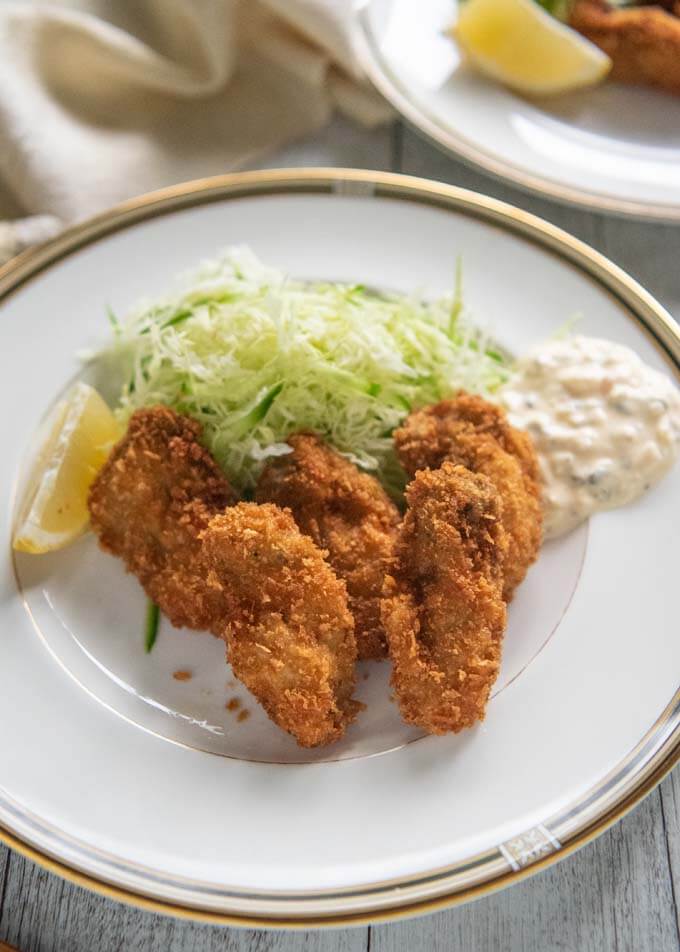
In Australia, the most popular way of eating oysters is eating them raw with some dressings or just lemon juice. But in Japan, cooked oysters are more commonly consumed than raw oysters.
Deep-fried Crumbed Oysters are called ‘kaki furai’ (牡蠣フライ or かきフライ) in Japanese. Oyster is ‘kaki’ (牡蠣 or かき) and ‘furai’ (フライ) is the English word ‘fry’ pronounced in the Japanese way. Hence, I spelt it Kaki Fry in the post title.
You may recall that persimmon is also ‘kaki’ in Japanese. I mentioned this in my post Persimmon Daikon Salad. Both of them have the same phonetics but the Kanji characters are different. The kanji character for persimmon ‘kaki’ is 柿.
The pronunciation is slightly different too, having a stress on ‘ka’ for oyster and ‘ki’ for persimmon. But that’s the Kanto (the eastern region of Japan) accent. In Kansai (the western region), it is almost the other way round.
Oysters from Hiroshima
I bought a 1Kg/2.2lb bag of frozen oysters from a Japanese grocery store. You may even be able to find them in some Asian grocery stores. They are from Hiroshima (広島), which is famous for having the largest production of quality oysters in Japan.
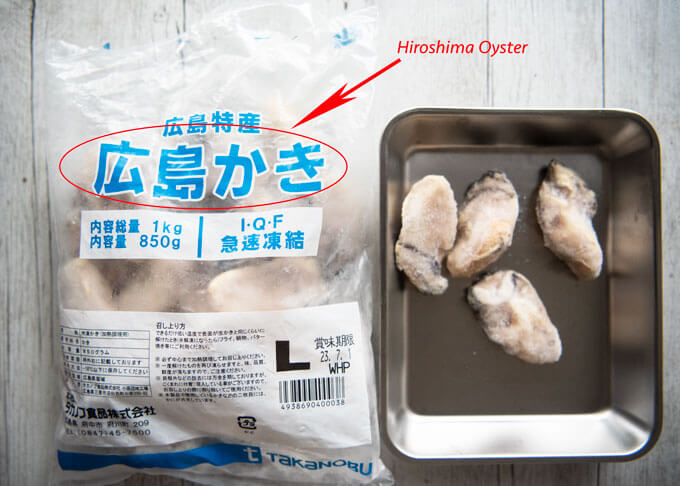
Compared to the standard shucked oysters that you get from fish markets in Sydney, the size of the frozen oysters is larger, which is perfect for today’s dish. You don’t want to deep-fry tiny oysters.
When searching for a bag of frozen oysters, I strongly recommend trying to find a bag labelled as Hiroshima oysters.
The roots of oyster farming in Hiroshima go back more than 450 years ago, in the Muromach period (1336 – 1573). After World War II, they invented a particular method of growing oysters beneath the rafts which contributed to larger production of oysters.
Hiroshima Bay, where oysters are farmed, is considered to be the best environment to grow oysters. Because it is a bay in the Inland Sea, the sea is calm with an adequate level of tide. The oysters grow well by eating plankton carried into the bay from the rivers.
I travelled to Itsukushima Shrine in Hiroshima, best known for its floating ‘torii’ gate, a few years ago. I had a grilled oyster there and it was so large, plump, and tasty!
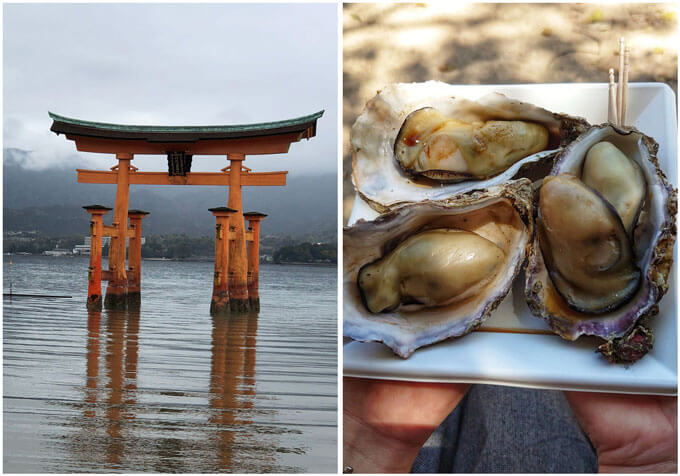
Floating torii and plump grilled Hiroshima oysters.
What’s in My Deep-fried Crumbed Oysters (Kaki Fry)
- Frozen oysters
- 3% salt water
- Pepper
- Flour
- Beaten egg
- Panko breadcrumbs
- Oil to deep-fry (not in the photo)
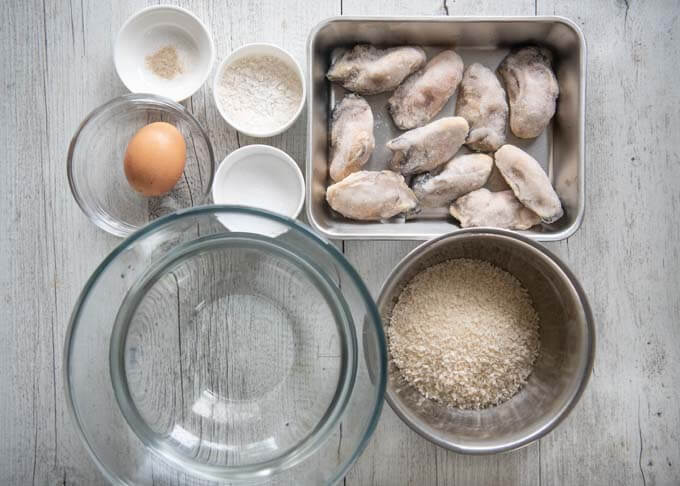
The ingredients are no different to other deep-fried crumbed dishes such as Tonkatsu – the key ingredient, seasoning, and coating ingredients.
Salt water is used to thaw frozen oysters. The saltiness is made to be similar to the sea. Because of this, I only need pepper to season the oysters.
Serving
- Shredded cabbage with julienned cucumbers
- Tartar sauce or tonkatsu sauce
- Lemon wedges
Like any other deep-fried crumbed dishes, I serve Kaki Fry with shredded cabbage. I added cucumbers to give colour to the dish, but you can just put a sprig of parsley on top instead, which is a common way of serving Kaki Fry at restaurants.
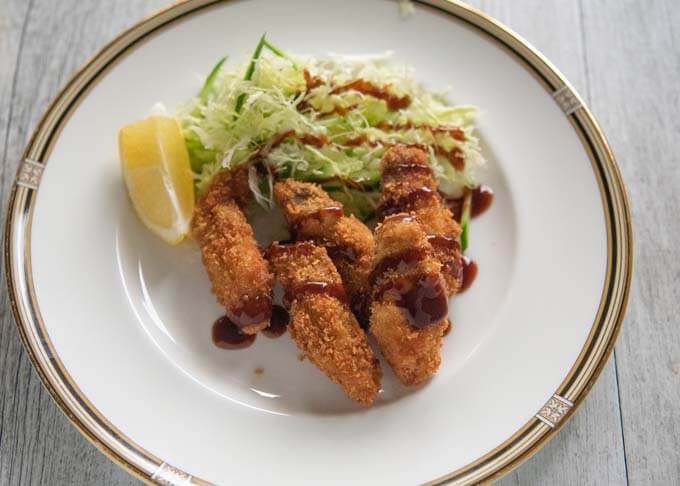
I like eating Kaki Fry with a fruity tonkatsu sauce (like the photo above) but at restaurants, they are often served with the Japanese version of tartar sauce. So, I added a recipe for Japanese-style Tartar Sauce.
Japanese-style Tartar Sauce
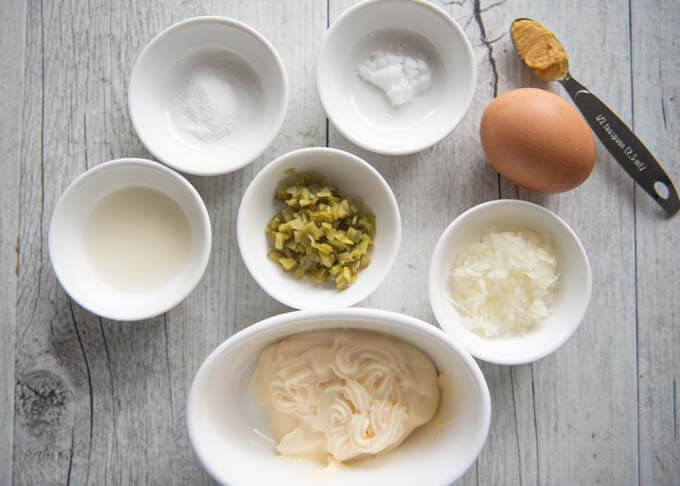
- Kewpie mayonnaise
- Finely chopped onion
- Diced boiled egg
- Finely chopped gherkin/cornichon
- Lemon juice
- Hot mustard paste
- Sugar
- Salt
- Pepper (I forgot to include this in the photo above)
Apart from using Kewpie mayonnaise, which is less sour and slightly sweeter than Western-style mayonnaise, the Japanese version of tartar sauce uses finely chopped boiled egg.
How to Make Deep-fried Crumbed Oysters (Kaki Fry)
The fundamental process of making Kaki Fry is pretty simple, as you can see in the following steps and the video.
- Thaw oysters.
- Season oysters.
- Coat the oysters with flour, egg, then breadcrumbs.
- Deep-fry until golden brown – double fry at 160°C/320°F first, then at 180°C/356°F.
- Serve with Japanese-style Tartar Sauce or tonkatsu sauce.
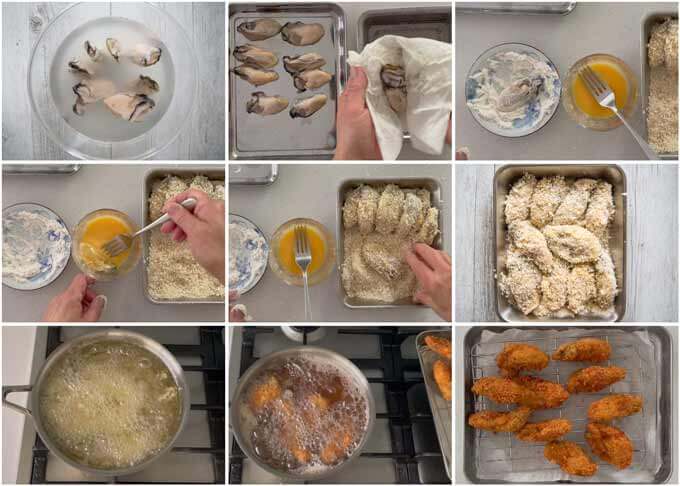
Frozen ingredients often disappoint me as they tend to lose flavour in the process of defrosting them. But you can overcome this problem by thawing the oysters in the right way (see the next section) to enjoy flavoursome and juicy Kaki Fry.
Tartar Sauce is made by simply mixing the ingredients, after removing the pungent taste by leaving the onion in water for a while.
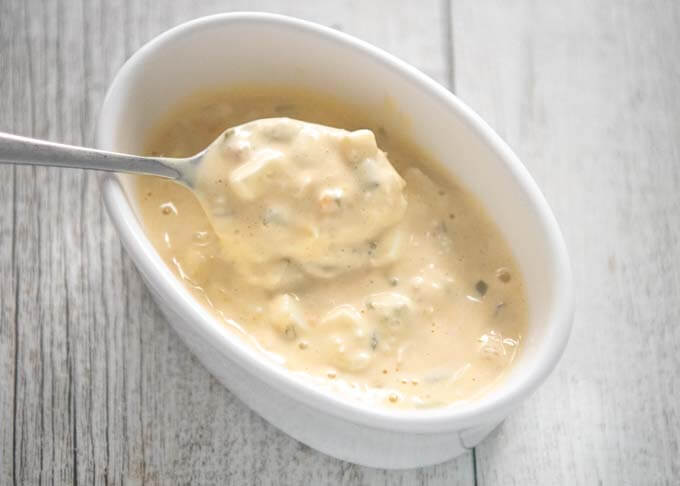
How to Thaw Frozen Oysters
There are two key points to remember:
- Thaw in salt water that is similar to sea water – I made 3% salt water.
- Cook oysters semi-frozen – the surface is soft but inside is frozen and still very hard.
If you thaw the oysters in water without salt, the oysters absorb water into the flesh due to osmotic pressure. This will cause shrinkage of the oysters when deep-fried as the water leaks out of the flesh.
If you thaw oysters completely, flavours and umami will be lost in the defrosting process. By keeping part of the oysters frozen, you can lock the good flavours inside the flesh.
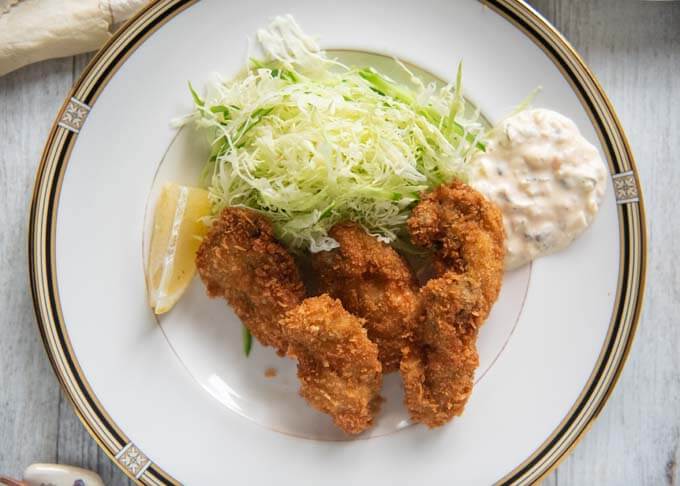
I love deep-fried crumbed dishes such as Korokke, Tonkatsu, and Aji Fry, but I must say that Kaki Fry makes the top 3 of my favourite crumbed dishes. It is best to eat Deep-fried Crumbed Oysters while hot.
Yumiko![]()
Watch How To Make It
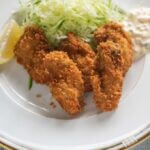
Crunchy outside and juicy inside, Deep-fried Crumbed Oysters is one of the best ways of eating oysters in my view. Shucked oysters are very fresh but expensive, so I used frozen oysters to make Deep-fried Crumbed Oysters. Watch the video.
Don't forget to see the section 'MEAL IDEAS' below the recipe card! It gives you a list of dishes that I have already posted and this recipe that can make up a complete meal. I hope it is of help to you.
- 10 frozen oysters (note 1)
- 1000ml/2.1pt water (note 2)
- 30g/1.1oz salt (note 2)
- Pepper
- 2 tbsp flour
- 1 egg beaten
- 1 cup Panko breadcrumbs (note 3)
- Oil for deep-frying
- 1 boiled egg finely diced
- 4 tbsp Kewpie mayonnaise (note 4)
- 1 tbsp gherkin/cornichon finely chopped
- 1 tbsp onion finely chopped
- 1 tsp lemon juice
- ½ tsp sugar
- ¼-½ tsp salt
- Pepper
- Shredded cabbage with cucumbers julienned (note 5)
- Japanese-style Tartar Sauce or tonkatsu sauce (note 6)
- Lemon wedges
-
Dissolve 30g/1.1oz salt in 1000ml/2.1pt water to make 3% salt water.
-
Put the frozen oysters in the salt water and leave them for 5-15 minutes (note 7) until the surface of the oysters is thawed, but inside is still frozen and hard.
-
Using paper towel, pat dry each oyster. Move to the next step without delay so that the oysters are still semi-frozen.
-
Sprinkle pepper over the oysters.
-
Place flour, egg and breadcrumbs in a shallow plate or bowl individually and line them up in this order.
-
Working one oyster at a time, coat an oyster with flour thoroughly, then place it in the egg and coat all over. Allow excess egg to drip, then transfer to the breadcrumbs.
-
Cover the entire oyster with breadcrumbs, making sure that a good layer of breadcrumbs is stuck on all around the oyster.
-
Repeat the steps 3 and 4 for the rest of the oysters.
-
Heat oil in a deep-frying pan to 160°C/320°F (note 8). The amount of oil should be about 3-3.5cm/1¼-1⅜” deep.
-
Gently place oysters into the oil. Depending on the size of the pan, you may need to fry in batches. Do not overcrowd the pan (note 9).
-
Fry for about 2½-3 minutes or until the surface of the oysters become light brown. Transfer the oysters to a tray with a cooling rack or lined with a couple of layers of paper towel.
-
When all the oysters are fried, turn the heat up to 180°C/356°F (note 8) and fry the oysters again (note 9) for 15 seconds or so until golden brown. Transfer the oysters to the tray.
-
Pile shredded cabbage on one side of a serving plate and put a lemon wedge next to it.
-
Place oysters leaning against the cabbage, placing them in the same direction, with the gills side facing upward.
-
If serving with Japanese-style Tartar Sauce, put the sauce on the side next to the oysters. If serving with Tonkatsu sauce, put the sauce in a separate jar.
-
Serve immediately while hot.
-
If your onion is extremely pungent, leave the chopped onions in water for 10 minutes. Drain through a fine-mesh sieve, then squeeze the water out.
-
Put all the Japanese-style Tartar Sauce ingredients in a bowl and mix well.
1. My frozen oysters weighed about 200g/7.1oz and there was minimum ice around the oysters. They were about 6cm/2⅜" long.
If you prefer, you can use fresh oysters or oysters in a jar. It is best to use 5-6cm/2-2⅜" long oysters for frying.
2. If you are not using frozen oysters, you don’t need these. Then you need to season oysters with salt when sprinkling pepper over them.
3. For Kaki Fry, I strongly recommend using panko, or even freshly grated bread. The large crumbs make the coating crunchy when fried.
4. Kewpie mayonnaise is not as sour as the Western-style mayonnaise. If you are substituting it with Western-style mayo, omit lemon juice.
5. Instead of adding cucumber pieces, you can place a sprig of parsley on top if you like.
6. I used Bulldog brand tonkatsu sauce. You can find more details about Bulldog sauces in my post Yakisoba.
7. Depending on the water and room temperature, the time taken to partially thaw varies.
8. Add a couple of breadcrumbs into the oil and if the bubbles around the crumbs are small and slowly increasing, it is about 160°C/320°. If the crumbs are surrounded by lots of bubbles, it is about 180°C/356°F.
9. I used a small pan and fried the oysters in 2 batches.
Every time you remove oysters from the oil and before frying the next batch of oysters, scoop the crumbs from the oil using a flat sieve with fine mesh (see the video). This will prevent crumbs left in the oil from getting overcooked and blackened. The burnt crumbs tend to stick to the crumbs around the oysters and make them look dirty.
10. Nutrition per serving. It assumes that the oil absorption rate is 30% of the total weight of oysters.
serving: 163g calories: 453kcal fat: 32g (49%) saturated fat: 3g (15%) trans fat: 0.2g polyunsaturated fat: 6.2g monounsaturated fat: 21g cholesterol: 92mg (31%) sodium: 892mg (37%) potassium: 241mg (7%) carbohydrates: 28g (9%) dietary fibre: 1.6g (6%) sugar: 1.7g protein: 14g vitamin a: 6.3% vitamin c: 12% calcium: 5.4% iron: 36%
Meal Ideas
A typical Japanese meal consists of a main dish, a couple of side dishes, a soup and rice. I try to come up with a combination of dishes with a variety of flavours, colours, textures and make-ahead dishes.
My meal combination rules are that you match with a refreshing dish when you have a deep-fried dish, while considering colour balances. So, I pickled daikon salad as one of the side dishes. Daikon is an excellent vegetable to go with the fried dish.
The other side dish needs to be a colourful one and perhaps the typical Japanese flavour, sweet soy flavour. It can be any of the simmered dishes, but I picked Hijiki no Nimono to add different colours to the meal.
Today’s soup is a clear soup with whiting to supplement protein.
- Main: Deep-fried Crumbed Oysters (Kaki Fry) – today’s recipe.
- Side dish 1: Hijiki Seaweed Salad (Hijiki no Nimono) – make ahead, or other simmered dish such as Simmered Kiriboshi Daikon (Dried Shredded Daikon) or Simmered Pumpkin (Kabocha no Nimono).
- Side dish 2: Daikon Salad with Pickled Plum Dressing – or other fresh salad.
- Soup: Japanese Clear Soup with Whiting (Kisu no Osuimono) – or other clear soup such as Dried Tofu Skin Soup.
- Rice: Cooked Rice.
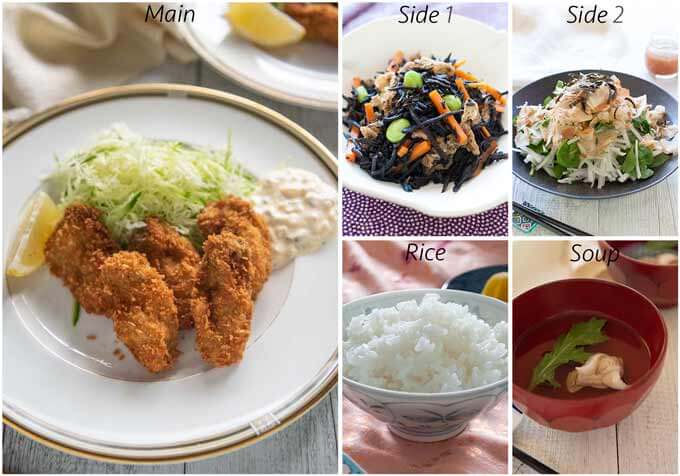
These look good. Can they be done in the air fryer.
Hi John, I am sure you can do it. I don’t have an air fryer, so I cannot give you a detailed cooking method. But based on what I read:
1. Instead of applying flour and beaten egg individually, mix the flour and the egg well, then dip the oysters in it before coating your oysters with breadcrumbs.
2. Some recipes spray oil over the breadcrumbs, some don’t.
3. Cook at 200°C/392°F. I cannot be certain of the cooking duration, but I presume it is longer than deep-frying. If you have a cooking time for crumbed shrimp or something, it might be similar to that.
The breadcrumbs won’t be nicely browned all over.
Hello Yumiko. Your recipes are the best. Easy to follow and always tasty. I’ll try this tomorrow. I know it will be a hit. Can I use fresh oysters? Thanks
Hi Dee, yes of course, you can use fresh oysters. Please let me know how it went.
Hello Yumiko. Your recipes are the best. Easy to follow and always tasty. I’ll try this tomorrow. I know it will be a hit. Thanks